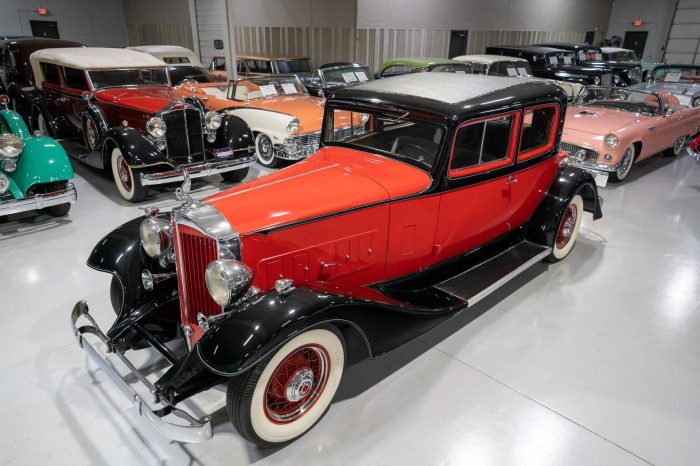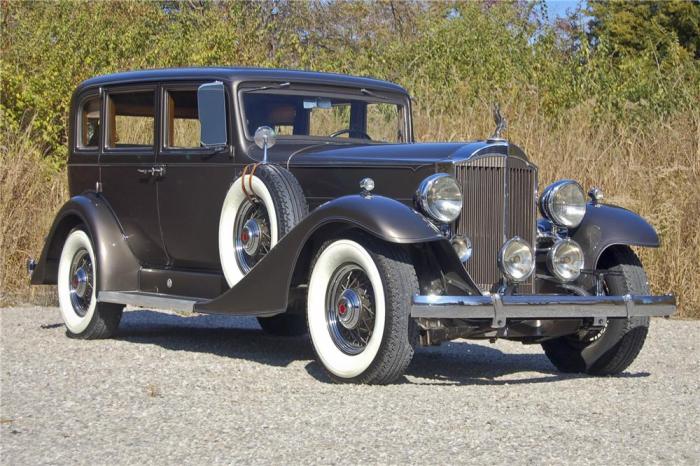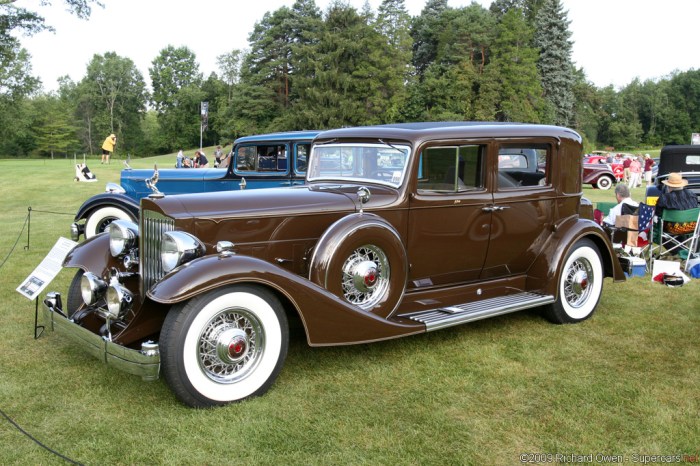The 1933 Packard Eight, a symbol of opulence in the midst of the Great Depression, offers a fascinating glimpse into the world of American luxury automobiles. This era was a stark contrast to the booming 1920s, and the Packard Eight stood as a beacon of extravagance, representing a resilience and a desire for grandeur amidst hardship.
The Packard Motor Car Company, known for its craftsmanship and engineering prowess, was determined to maintain its position as a leader in the luxury car market, even as the nation grappled with economic turmoil.
The 1933 Packard Eight, with its powerful engine and elegant design, was a statement of both power and refinement. Its sleek lines and intricate details showcased the artistry of the era, while its performance on the road exemplified the technological advancements of the time.
It was a car for those who wanted to stand out, who wanted to make a statement about their status and their enduring spirit.
Historical Context

The 1933 Packard Eight emerged during a tumultuous period in American history, the depths of the Great Depression. The economic and social landscape was drastically altered, casting a long shadow over all industries, including the automotive sector.
The Great Depression and Its Impact on the Automotive Industry
The Great Depression, which began in 1929, plunged the United States into an unprecedented economic downturn. Unemployment soared, businesses shuttered, and consumer spending plummeted. The automotive industry, once a symbol of American prosperity, was particularly hard hit.
- Production Slump:Car production plummeted from a peak of 5.6 million units in 1929 to a mere 1.3 million in 1932.
- Declining Sales:With widespread unemployment and diminished purchasing power, car sales plummeted, forcing manufacturers to slash production and lay off workers.
- Bankruptcies and Mergers:Many smaller automotive companies were unable to weather the storm, leading to bankruptcies and mergers.
The Significance of Packard Motor Car Company During the Great Depression, 1933 Packard Eight
Despite the dire economic circumstances, the Packard Motor Car Company remained a beacon of luxury and prestige. Packard’s commitment to quality craftsmanship and innovative engineering helped it weather the storm, though not without challenges.
- Maintaining Quality:Even in the face of declining sales, Packard refused to compromise on its commitment to quality. The company continued to produce meticulously crafted automobiles, using premium materials and advanced engineering.
- Appealing to a Niche Market:Packard targeted a wealthy clientele who could afford its luxury cars, even during the Depression. This strategy helped the company maintain its market share and profitability.
- Innovative Engineering:Packard continued to invest in research and development, introducing innovative features such as the “Safety-Control” hydraulic brakes and the “Silent Eight” engine.
The 1933 Packard Eight Model

The 1933 Packard Eight was a significant car in Packard’s history, representing a transition to a more streamlined and modern design philosophy. It offered a blend of luxury, performance, and innovation, solidifying its position as a leading player in the luxury automotive market.
Key Features and Specifications
The 1933 Packard Eight was available in a variety of body styles, including sedans, coupes, convertibles, and limousines. It was powered by a straight-eight engine, a hallmark of Packard’s engineering prowess, with various displacement options. The engine was renowned for its smooth operation and impressive power output.
- Engine:Straight-eight, with displacement options ranging from 384 to 445 cubic inches.
- Horsepower:Varied depending on the engine size, ranging from 106 to 140 horsepower.
- Transmission:Three-speed manual or a two-speed semi-automatic transmission.
- Body Styles:Offered in a wide range of body styles, including sedans, coupes, convertibles, limousines, and station wagons.
- Features:Included features like hydraulic brakes, independent front suspension, and a variety of luxurious appointments.
Comparison with Other Luxury Cars of the Time
The 1933 Packard Eight competed with other luxury cars of the time, such as the Cadillac V-16, the Duesenberg, and the Pierce-Arrow. While these cars were all known for their luxury and performance, the Packard Eight stood out with its affordability and its more accessible price point.
| Car | Engine | Horsepower | Price |
|---|---|---|---|
| 1933 Packard Eight | Straight-eight, 384-445 cubic inches | 106-140 hp | $2,295
|
| 1933 Cadillac V-16 | V-16, 452 cubic inches | 165 hp | $5,995 |
| 1933 Duesenberg Model J | Straight-eight, 420 cubic inches | 265 hp | $12,000 |
| 1933 Pierce-Arrow | Straight-eight, 430 cubic inches | 135 hp | $3,195
|
Design and Aesthetics

The 1933 Packard Eight was a car that embodied the height of luxury and sophistication in the early 1930s. Its design philosophy aimed to create a vehicle that was both stylish and powerful, reflecting the economic prosperity and technological advancements of the era.
Exterior Styling
The exterior styling of the 1933 Packard Eight was characterized by its sleek, flowing lines and elegant proportions. The car’s long, low hood and high, sweeping fenders gave it a sense of motion even when standing still.
- The grillewas a prominent feature, featuring a series of vertical chrome bars that were reminiscent of the Art Deco style that was popular at the time. The grille was flanked by two large, round headlights that were set into the fenders.
- The headlightswere also notable for their distinctive teardrop shape, which added to the car’s overall sense of elegance. The car’s body lines were clean and uncluttered, with a focus on creating a sense of harmony and balance.
- The bodyworkwas crafted from high-quality steel, and the car’s paint was applied with meticulous attention to detail. The 1933 Packard Eight was available in a variety of colors, including black, blue, green, and maroon.
Interior Design
The interior of the 1933 Packard Eight was just as luxurious as its exterior. The car’s cabin was spacious and comfortable, with plush leather upholstery, wood trim, and a variety of amenities.
- The seatingwas designed for comfort and spaciousness, with ample legroom and headroom for all passengers. The car’s seats were upholstered in high-quality leather, and they were often available in a variety of colors and patterns to match the owner’s taste.
- The dashboardwas a masterpiece of craftsmanship, featuring a variety of gauges and controls that were arranged in a logical and easy-to-use manner. The dashboard was typically made of polished wood, and it was often adorned with chrome accents.
- The interior materialswere chosen for their quality and durability. The car’s upholstery was made of high-quality leather, while the wood trim was typically made of walnut or mahogany. The car’s carpeting was made of thick wool, and the headliner was often covered in a luxurious fabric such as mohair.
Performance and Handling

The 1933 Packard Eight, with its powerful engine and substantial size, offered a driving experience that was both luxurious and capable. It wasn’t just about speed; it was about the smooth, effortless manner in which it delivered power and the feeling of confident control it provided to its driver.The Packard Eight’s performance was impressive for its time.
The 1933 Packard Eight, a symbol of luxury and power in its time, marked a significant shift in the automotive landscape. While it boasted a powerful engine and elegant design, the 1933 model paved the way for future innovations, like the 1955 Packard Patrician , which introduced even more advanced features and a distinctive, futuristic aesthetic.
The 1933 Packard Eight, however, continues to be a cherished classic, embodying the spirit of a bygone era of automotive excellence.
It could reach speeds of up to 80 miles per hour, which was considered quite fast for a car of its era. The 384 cubic inch straight-eight engine, coupled with a three-speed manual transmission, provided ample power for both city driving and highway cruising.
Performance
The Packard Eight’s performance was a testament to its engineering. The 384 cubic inch straight-eight engine, producing 125 horsepower, delivered a smooth and powerful driving experience. The car’s acceleration was not as rapid as some modern vehicles, but it was still considered quite impressive for its time.
The Packard Eight could reach 60 miles per hour in approximately 15 seconds. This was a respectable time, especially considering the car’s size and weight.
Handling
The Packard Eight’s handling was also noteworthy. While not as agile as some modern cars, it provided a comfortable and confident ride. The car’s long wheelbase and substantial weight contributed to a stable and predictable handling experience. The Packard Eight’s steering was precise, but it required a bit more effort than modern power steering systems.
The 1933 Packard Eight was a marvel of engineering, showcasing the brand’s commitment to luxury and performance. While the 1933 model was lauded for its innovative features, the following year saw the introduction of the 1935 Packard Eight , which built upon its predecessor’s success with even more refined styling and advanced mechanicals.
Both models are considered classics of the era, offering a glimpse into the golden age of American automotive design.
The brakes, while effective, were not as responsive as modern disc brakes. Despite these differences, the Packard Eight offered a comfortable and controlled driving experience that was appreciated by drivers of the time.
Cultural Impact and Legacy: 1933 Packard Eight

The 1933 Packard Eight was not just a car; it was a symbol of luxury, power, and prestige in the midst of the Great Depression. It was a statement of success in a time when most people were struggling to survive.
Its influence extended beyond the realm of transportation, impacting popular culture, automotive design, and even the American psyche.
The Packard Eight’s Role in Popular Culture
The Packard Eight’s presence in popular culture was undeniable. Its sleek lines and luxurious features made it a favorite of Hollywood stars and the elite.
- The car appeared in numerous films, often serving as a symbol of wealth and sophistication. For example, the 1933 Packard Eight was prominently featured in the 1934 film “It Happened One Night,” starring Clark Gable and Claudette Colbert.
- The car also made its way into popular literature. Authors like F. Scott Fitzgerald and Ernest Hemingway often used the Packard Eight as a symbol of the Roaring Twenties and the American Dream.
The Packard Eight was not only a symbol of luxury but also a status symbol. Its presence in popular culture helped to cement its place as a car for the elite, reinforcing its association with wealth and success.
Final Thoughts

The 1933 Packard Eight, a testament to American ingenuity and craftsmanship, remains a captivating symbol of a bygone era. Its legacy extends beyond its time, serving as a reminder of the enduring appeal of luxury and the power of design to transcend economic hardship.
It continues to inspire awe in automotive enthusiasts and collectors alike, standing as a reminder of the enduring spirit of American luxury.